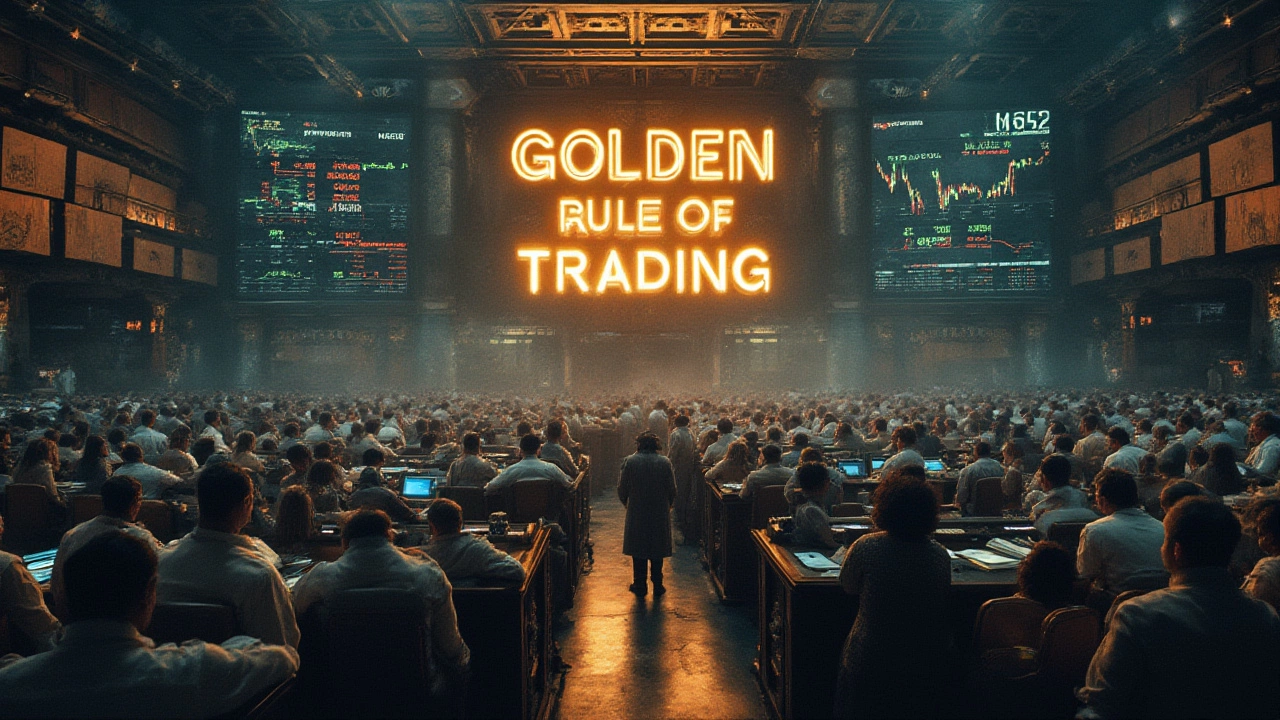
Ever heard someone brag about turning a few bucks into a fortune overnight? The trading world is full of wild tales. What usually stays hidden? The laundry list of painful losses, stressful nights, and dreams dashed by reckless bets. At the heart of every story—win or lose—sits one big question: is there a Golden Rule that separates real traders from gamblers chasing luck? Spoiler: it's not some secret code only Wall Street knows. It's about staying in the game, protecting your sanity (and bank account), and knowing when to step back.
Understanding the Golden Rule of Trading
You’ll hear different versions of the golden rule. Some swear by "Cut your losses quickly, let your winners run." Others focus on "Never risk more than you can afford to lose." At its core, though, the golden rule of trading is discipline. Not skill with a crystal ball, not magic chart patterns, but sticking to a set of rules—even when every nerve tells you to panic or get greedy.
Legendary trader Paul Tudor Jones said it best: "The most important rule of trading is to play great defense, not great offense." It sounds boring. But almost every trading book, course, or seasoned investor will come back to the same basic lesson: “Don’t lose so much in one trade you can’t recover.”
If you look at the pros, you'll notice the same behaviors. They set strict boundaries, use stop-loss orders, follow position sizing rules, and never risk their entire stack on one wild guess. This isn't just theory—it's what keeps them in the game when others get wiped out.
Take a look at the 2020 stock market crash. While plenty of beginners panicked and liquidated everything at a loss, disciplined traders had a plan. Some made money on the way down using hedges, but more importantly, most survived to trade another day because they didn’t bet the farm on any single outcome.
You might wonder: if it’s that simple, why do so many fail? Because discipline sounds easy but is brutally hard when actual money is at stake. The urge to chase a rebound or hold out 'just a little longer' when a trade turns bad is strong—even among pros. But those who follow the golden rule outlast the rest. They might miss a big winner now and then, but they avoid the kinds of disastrous losses that knock you out of the game completely.
Why Most Traders Ignore the Golden Rule—and Pay the Price
Let’s be blunt—discipline is boring. It means accepting small, consistent gains instead of chasing lottery-ticket wins. For every person holding a crypto coin that explodes, there are hundreds who lose big and disappear from the conversation. Here are the numbers that pull back the curtain:
| Stat | Source/Year | Details |
|---|---|---|
| Annual % of day traders who lose money | Barber & Odean (2014) | 80-90% |
| % of day trading volume funded by debt | FINRA (2023) | 34% |
| Average lifespan of a new trader's account | NerdWallet (2022) | Less than 12 months |
Why do traders fall into this trap? Social media glamorizes big wins but rarely highlights failures. The emotional highs and lows feel addictive, like gambling. And the market itself is unpredictable—sometimes bad habits get rewarded, signaling that rules can be skipped. But the market never forgets. Over time, ignoring discipline means getting hit eventually.
I’ve seen it play out. Back when meme stocks exploded, everyone in my WhatsApp groups was convinced they uncovered a new way to get rich. Some ignored stop losses entirely, holding until their stocks tanked 70%—and hoping for a miracle. When you lose money you can’t afford, the stress stays with you, impacting work, family, and even sleep. Trust me, my dog Rusty has had to listen to plenty of my loud sighs after a rough day’s trading.
Ignoring the golden rule doesn’t just cost money. It can mean ruined credit, lost confidence, and years digging out of a hole. Don’t fall for highlight reels or rumors that rules don’t matter. The graveyard of failed traders is full of rule-breakers who thought they were special.

How to Apply the Golden Rule: Practical Tips and Real-World Habits
Okay, so being disciplined is the main rule. But what does that look like in your day-to-day trading life? Here’s what works for real traders who last longer than a season:
- Set Your Maximum Risk Per Trade: A classic guideline? Never risk more than 1-2% of your account on any single trade. That way, even a string of losers won’t wipe you out.
- Use Stop-Loss Orders: These automatically close your position if the price moves against you. Don’t move your stop once it’s set, hoping for a bounce. That’s wishful thinking dressed as strategy.
- Plan Every Trade: Decide your entry, exit, and target before you place a trade. Write it down. Treat your trading like a business, not a weekend lottery ticket.
- Keep a Trading Journal: After every trade, jot down what happened and how you felt. You’ll spot patterns in your decision-making and see which rules you’re breaking (or keeping).
- Step Away When You Lose: Taking a break prevents revenge trading—where you try to win back losses with bigger, riskier bets. Go walk your dog, make a coffee, or do anything but trade emotionally.
You don’t have to be a genius to win in the market, but you do have to be honest with yourself. Ask: ‘Am I sticking to my rules, or am I gambling right now?’ If you can’t answer, it’s time to slow down.
Seasoned traders invest in risk management tools—like position sizing calculators and alerts—to remove as many decisions as possible from the heat of the moment. If you’ve ever hit ‘Buy’ because of FOMO, you know how easy it is to trip up. Automation forces you to set rules in advance.
The Role of Psychology: Why Emotions Derail Even Smart Traders
Discipline beats intelligence in trading, but emotions try to ruin everyone’s plan. Human brains crave certainty and hate loss. Behavioral economics calls this ‘loss aversion.’ Losing $100 feels about twice as bad as gaining $100 feels good. That’s why, when a trade moves against us, instinct screams: "Wait, it’ll bounce back!" Or worse: "Double down—go big or go home."
Studies by the University of Cambridge show that traders under stress make more impulsive and riskier decisions, often abandoning carefully crafted rules. The neurotransmitter dopamine kicks in, especially when you unexpectedly win or lose, making trading feel like a high-stakes slot machine.
Here’s another kicker: confirmation bias. When we want something to be true, we hunt for data (or Twitter posts) to back it up, ignoring anything that says "cut your losses." Veteran traders know to fight this urge. They build routines—reviewing trades at the same time every week, or sticking with a checklist before executing any trade.
One practical trick? Take regular breaks, especially after a losing streak. Turn off screens, walk outside, pet your dog, or call a friend. Anything to clear your head. Most bad trades don’t hurt because of bad research—they sting when emotion runs wild and wipes out discipline.
Almost every major blow-up you read about—be it a hedge fund collapse or a meme-stock wipeout—has a root cause somewhere in a broken rule and an emotional overreaction. Learn to welcome boring, slow trading. It’s a tough sell, but boredom means you’re not making panic moves.

Golden Rule in Action: Stories, Data, and Lasting Wisdom
If you’re searching for a formula to always win, you’re in the wrong game. But if you make discipline your north star, you’ll be around long enough to catch those rare, big moves that can make a difference—without risking your whole future.
| Name | Success attributed to Discipline? | Key Rule |
|---|---|---|
| Jesse Livermore | Yes | Cut losses, ride winners |
| Ed Seykota | Yes | Risk control/stop-loss |
| Sara Blakely | Indirectly | Never risk more than you can lose |
The late Jesse Livermore, once the richest trader alive, famously lost most of his fortune by breaking his own rules. On the flip side, traders like Ed Seykota credited lifelong profits to ruthless application of stop-losses—even firing himself from certain trades by automation. If billionaires take it this seriously, maybe it’s worth following their lead.
Here’s a final nugget. In 2019, Fidelity reviewed the performance of its best retail traders. Turns out, many had actually forgotten about their accounts entirely—some had passed away. Doing less, not more, was the winning formula. They avoided emotional trades and gave winners time to grow.
Your version of the golden rule could be as simple as writing down your max risk percentage above your computer, or setting reminders to revisit your plan whenever you lose sight of it. If you can laugh about your mistakes (like when Rusty buries his treat and forgets where)—and get back to your plan—you’re ahead of the crowd.
No one can guarantee constant wins. But if you play defense as fiercely as you chase profits, you’ll stick around long enough to see the days when your patience finally pays off.





Write a comment